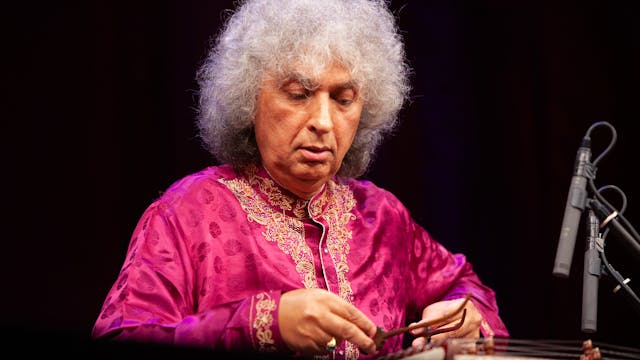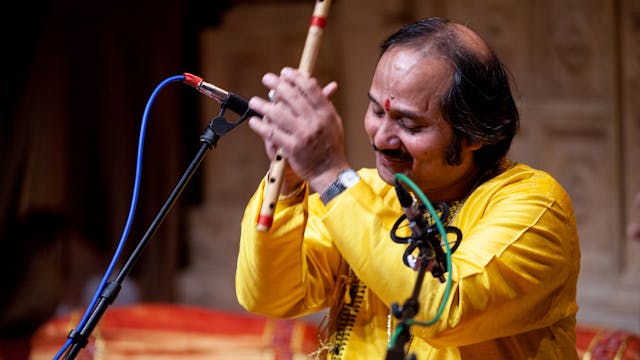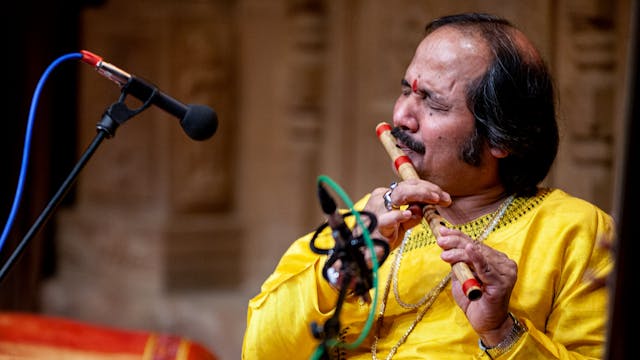Pandit Shivkumar Sharma | Puriya Kalyan
Hindustani Instrumental
•
59m
Recorded at Darbar Festival 2015, on 20th September at the Queen Elizabeth Hall, Southbank Centre, London.
Musicians:
- Pandit Shivkumar Sharma (santoor)
- Satyajit Talwalkar (tabla)
- Takahiro Arai (tanpura)
Raags:
- Raag Puriya Kalyan; Thaat: Marwa, Samay: Late Afternoon
- Raag Puriyan Dhanashree; Thaat: Poorvi; Samay: Late Afternoon
- Raag Yaman; Thaat: Kalyan, Samay: Evening
Introducing Raag Puriya Kalyan with a sparkling alap, Pandit Shivkumar Sharma builds the evening raga bridging the lower and middle octaves with the lower Ni and anchoring on Pa, its dominant note. Raag Puriya Kalyan is performed during the time of ‘deep-jyoti’. ‘Deep’ means earthen lamp and ‘jyoti’ means halo. Women in most parts of India light an earthen lamp and place it under a holy basil shrub within the courtyard of the house just as darkness befalls after dusk. This custom is believed to ward off evil spirits from the household and bring prosperity to the family.
Raag Puriya Kalyan evokes peace and joy, but according to Pandit Sharma, a raga also inherits the personality, temperament and individual taste of the musician who is expressing it.
A vibrant jod reverberating with a groovy, linear rhythm follows the alap after which, Pandit Sharma plays a madhyalay gat in Jhaptaal. The gat takes off from the 8th beat, a difficult spot but one that becomes magical with the mastery that the greatest living santoor legend lends to it. This is followed by another gat in drut Teental in which, Pandit Sharma weaves spectacular combinations creating newer territories within the regions where Kalyan and Puriya Dhanashree overlap.
Ramkumar Mishra offers a commendable support. His tabla strokes are confident and full of gumption. Right from the beginning where he introduces his accompaniment with a small upaj till the end of this recital, Mishra gives his best, maintains the same level of energy and rivets his improvisations in between with sureness.
Raag Puriya Kalyan is derived from Marwa thaat. It is a sampurna raga that uses all the notes in the octave. Re is komal or flat and Ma is teevra. The rest of the swars are shudh or pure. The ascent is direct and the descent is meandering. The dominant or vadi swar is Sa and its sub-dominant or samvadi swar is Pa. Its arohana and avarohana are as follows:
S. r G M P D n S’
S’ N D P M G r G r S.
The samvadi swar plays a crucial role in expressing the auspicious and joyful mood of this raga. This raga is a blend of Raag Yaman in the lower and middle octaves and Raag Puriya Dhanashree in the upper octave.
Up Next in Hindustani Instrumental
-
Pandit Shivkumar Sharma | Mishra Kaus...
Raag Kaushik Dhwani was previously known as Bhinna Shadaj. ‘Bhinna’ means differentiated and ‘Shadaj’ means the first note or Sa. Pandit Shivkumar Sharma performs a lighter piece based on this raga. He bases the main melodic lines on Kaushik Dhwani and introduces an element of surprise in almost ...
-
Ronu Majumdar | Raag Bhoopkali
Recorded at Darbar Festival 2006, on 5th March, at the Peepul Centre, Leicester.
Musicians:
- Pandit Ronu Majumdar (bamboo flute)
- Subhankar Banerjee (tabla)
- Gunwant Dhadyalla (tanpura)Alaap and jod in Raag Bhoopkali, Thaat: Kalyan; Samay: Evening
Raag Bhoopkali is also known as Bhoopeshw...
-
Pandit Ronu Majumdar | Raag Shudh Sarang
Recorded at Darbar Festival 2006, on 5th March, at the Peepul Centre, Leicester.
Musicians
- Pandit Ronu Majumdar (bamboo flute)
- Subhankar Banerjee (tabla)
- Gunwant Dhadyalla (tanpura)Raag Shudh Sarang; Thaat: Kalyan; Samay: Late Morning
Raag Shudh Sarang is a derivative of the ‘Sarang’ f...



